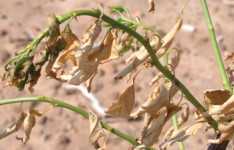Nitrogen is Most Import Element for Almond Growth

Nitrogen is the most important element we can apply to our tree fruit crops. Almond growth and productivity depend on the availability and uptake of nitrogen. Most fertilizer recommendations are based on making nitrogen available to our trees so that a nitrogen shortage does not limit tree growth or productivity.
However, it’s important for growers to keep in mind that young almond trees don’t require as much nitrogen as older trees. I like my fellow farm adviser Wilbur Reil’s rule of “1 ounce of actual nitrogen per year of age of tree.” That rate can be applied several times per season, but never more than that at any one application. Thus, a first leaf (first year in your orchard) almond tree should not receive more than 1 ounce of actual nitrogen per any application. A five-year-old almond tree should not receive more than 5 ounces of actual nitrogen per one single application.
The University of California only recommends 1 ounce of actual nitrogen per one-year-old tree over the course of the entire season, but I have been told by many growers and pest control advisers that this rate is not enough for the growth they desire. So, if you want to put out 5 ounces of actual nitrogen per one-year-old tree, do so in five applications and not all at once!
I have seen many trees burned by nitrogen, espe-cially if liquid fertilizers like UN-32 (urea ammonium nitrate 32%) or CAN 17 (a clear solution of calcium nitrate and ammonium nitrate) are used in single applications. These liquid fertilizers are very effective and easy to use, but it doesn’t take much to burn young trees. In fact, I do not recommend using these liquid fertilizers on first leaf trees — I prefer to see triple 15-15-15 (15% nitrogen; 15% phosphorous; 15% potassium) fertilizers used on first leaf trees. I like to see these granular fertilizers placed at least 18 inches from the trunk.
Can The Liquids
With micro-sprinkler and drip irrigation systems, liquid nitrogen fertilizers can be used very efficiently and easily by growers. But be careful; I know several farm managers that will not allow more than 10 gallons of UN-32 per acre per application on mature almond trees. UN-32 contains 3.54 pounds of actual nitrogen per gallon. If you put out 10 gallons of UN-32 per acre, you added 35.4 pounds of nitrogen per acre. If you have 120 trees per acre and do the math you come up with 4.72 ounces of actual nitrogen per tree — almost 5 ounces! I recommend not applying higher rates than this per application.
Also, growers should pay close attention during the summer months. I have seen nitrogen burn occur more often during hot summer days when trees have elevated transpiration rates and obviously faster nitrogen uptake rates than what would have occurred at a cooler time of the year.
Spoon Feed If Possible
If you plan on applying a total of 200 pounds of nitrogen per year per acre to your orchard, I would prefer to see you add 10 pounds of actual nitrogen in 20 irrigations over the course of the season, rather than applying it all at once or even in two split applications of 100 pounds each. I know many growers who “spoon feed” their trees with injections of nitrogen and other liquid fertilizers into their irrigation systems, and they seem quite pleased with the fertilizer efficiency.
Another factor is that mature trees need more nitrogen in early spring so you may want to emphasize applying more nitrogen earlier in the season than later. Nitrogen uptake has been shown to be correlated with leaf activity and photosynthesis. Thus, dormant winter applications of nitrogen should be avoided!









